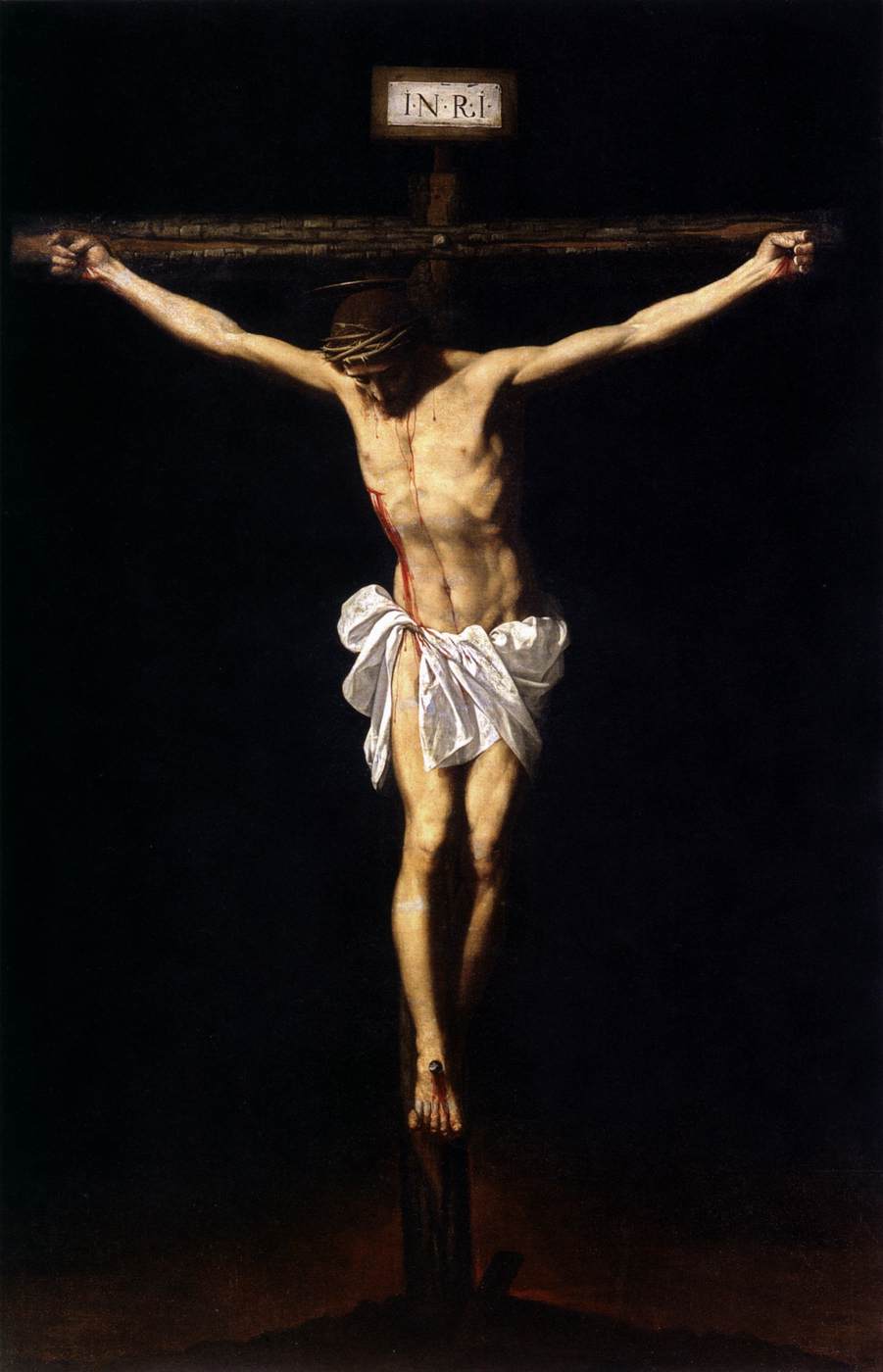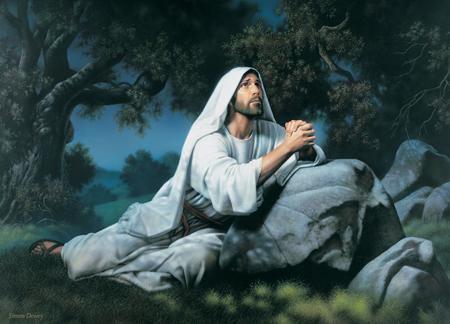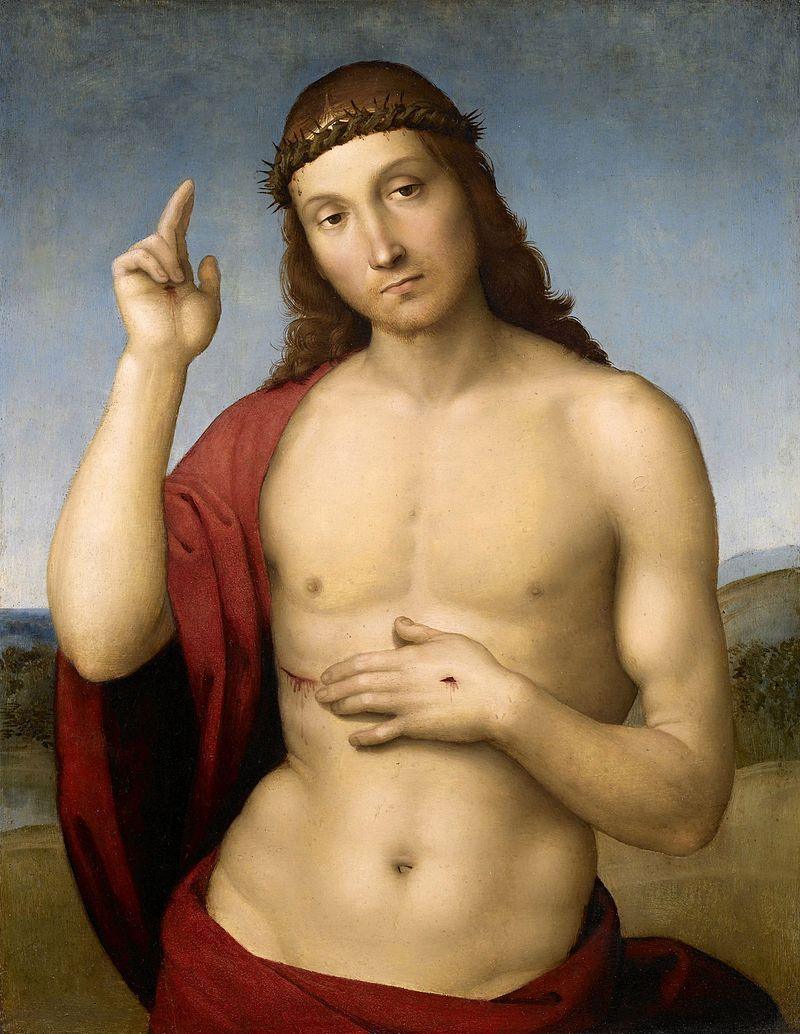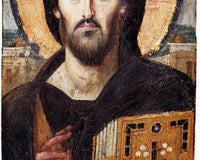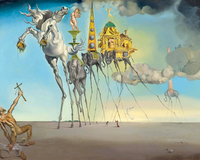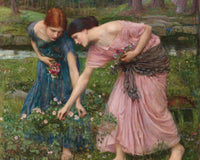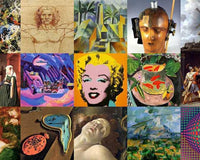Many of the works in the list below have been stolen.
Others destroyed by man or nature and some simply do not have an exact known final destination. The reasons for which these treasures were lost are different, but in all cases there is a common culprit: mankind.
No.1 The Colossus of Rhodes

One of the Seven Wonders of the Ancient World, The Colossus of Rhodes was a massive bronze statue of the sun god, Helios, that stood over the Greek city of Rhodes. The statue was located by the city’s harbor from 280 BC, being one of the most important commercial ports of the ancient Mediterranean.
Helios was a descendant of the Titans Hyperion and Theia. A place where Helios was particularly worshipped was Rhodes, the largest of the Dodecanese islands in the eastern Mediterranean. Rhodes was a polis, or city-state, and generated a lot of money from its lucrative control of trade. There seemed to be no better way to celebrate its commercial status than to commission a massive statue in honor of the city's god, a move that celebrated the freedom gained by the island.
The original giant statue measured 33 meters in height and, according to ancient reports, it took the sculptor Chares of Lindos 12 whole years to complete it. Although the Colossus certainly proved to be an incredible sight for visitors to the bustling port of the city, sadly, the giant Helios hardly stood for 56 years.
Knocked down by an earthquake in 228 or 226 BC, its broken pieces filled the docks of Rhodes for a millennium before melting into scrap by the mid-7th century. No drawing of the Colossus of Rhodes survives to this day, but ancient sources indicate that Helios was depicted standing with a torch held in his outstretched hand. These descriptions later served as inspiration for the design of the Statue of Liberty.
No.2 The Shield of Medusa - Leonardo da Vinci

The Shield of Medusa was lost to time, but it is one of those mysterious works of Leonardo da Vinci with a high level of spirit and debate.
According to a 1550 account by art historian Giorgio Vasari, the face was painted on a wooden shield cut from fig trees, as a favor for a peasant friend of his who designed the shield. Leonardo, in his experimental style, took the shield and heated it with fire and softened it.
As the story goes, when his father, Ser Piero, came to see the shield and knocked on the door, Leonardo told him to wait. He took the painting and adjusted it near a window with the soft light peeking through. Ser Piero entered and took a look at the painting and stepped back with a scream.
Leonardo then said: “This work serves the end for which it was made; take it and carry it away, for this is the effect it was meant to produce.”
The painting turned out to be so realistic that it initially frightened Leonardo's father, who considered it a somewhat macabre masterpiece and secretly sold it to a group of Florentine merchants.
The Shield of Medusa was meant to be one of those stories from Leonardo’s youth, so it could be in Vinci (in Tuscany, where Leonardo was born), or it could be in Florence.
The shield has long been missing, and some modern experts now argue that Vasari's story may have been little more than a myth, an urban legend of his time.
Buy a reproduction of The Shield of Medusa at the Kuadros online store
No.3 The Stone Breakers - Gustave Courbet

Realism and pure reality in a single work.
If we take a close look at Courbet's painting, The Stone Breakers, the artist's concern for the plight of the poor is evident.
The Stone Breakers, painted in 1849, depicts two common peasant workers. Courbet painted without any apparent feeling; instead, he let the image of the two men, one too young for forced labor and the other too old, express the feelings of hardship and exhaustion he was trying to portray. Courbet shows sympathy for the workers and disgust for the upper class by painting these men with their own dignity.
Inspired by a casual meeting with two oppressed workers, Courbet deliberately broke with the convention of the time, capturing the men with gritty details, from their tense muscles to their ragged and dirty clothing.
Traditionally, an artist spent most of their time on the hands, faces, and close-ups. This was not the case with Courbet. If you look closely, you’ll notice that he tries to be impartial, attending to the faces and the rock equally, setting aside the glamour that most French painters of that time added to their works. Because of this, Courbet became known as the leader of the realist movement.
While the painting helped launch Courbet's artistic career, "The Stone Breakers" was ultimately doomed to become one of the many cultural victims of World War II. In 1945, the painting was destroyed during an Allied bombing near the city of Dresden, Germany.
Buy a reproduction of The Stone Breakers at the Kuadros online store
No.4 Man at the Crossroads - Diego Rivera

Diego Rivera painted many populist murals and frescoes, but his most famous work may be one that no longer exists. In 1932, the Mexican artist was commissioned by John D. Rockefeller to create a mural for the walls of Rockefeller Center in New York.
The artist was given the theme: "the man at the crossroads looking with hope and high vision to choose a new and better future."
Rockefeller wanted the painting to make people stop and think. Rivera was to be paid $21,000 for the work. He was officially commissioned by Todd-Robertson-Todd Engineering, the agents developing the building. The full commission envisioned three murals. The Man at the Crossroads would be in the center. It would be flanked by The Border of Ethical Evolution and The Border of Material Development. The central composition was meant to contrast capitalism and socialism. This basic compositional idea was approved by Rockefeller.
On April 24, 1933, the New York World-Telegram published an article attacking the mural as anti-capitalist propaganda. A few days later, Rivera added the portrait of Lenin to the work. The leader appeared front and center, to the right. There, Lenin is seen holding hands with a group of multiracial workers.
Soldiers and war machinery occupied the upper left above the women of society, and a Russian May Day demonstration with red flags was seen on the right, above Lenin. For Rivera, this represented contrasting social visions: the "depraved rich" watched by the unemployed as war breaks out, while a socialist utopia was introduced by Lenin.
Of the hundreds of characters in Man at the Crossroads, Lenin was the most debated. A headline from April 24 in the New York World-Telegram declared "Rivera perpetuates scenes of communist activity for the RCA walls, and Rockefeller, Jr. Foots Bill.” Ten days later, Nelson Rockefeller, Rivera's patron and a member of a famous and wealthy family, asked the artist to remove Lenin. When Rivera refused, the artist was paid in full for his work and was dismissed. The murals were covered and then destroyed, while Rivera's supporters united to save the work.
Worried that Rockefeller would destroy the work, Rivera had asked an assistant, Lucienne Bloch, to take photographs of the mural before it was destroyed. Using them as reference, Rivera repainted the mural, albeit on a smaller scale, at the Palace of Fine Arts in Mexico City, where it came to be called Man, Controller of the Universe. The composition was almost identical, the main difference being that the central figure was shifted slightly to align with the support mast of the cylindrical telescope above him. The new version included a portrait of Leon Trotsky alongside Karl Marx and Friedrich Engels on the right, and others, including Charles Darwin, on the left, and Nelson Rockefeller's father, John D. Rockefeller, Jr., a lifelong teetotaler, drinking in a nightclub with a woman. Above their heads, the artist placed a plate of syphilis bacteria.
No.5 Portrait of Sir Winston Churchill - Graham Sutherland

In 1954, members of the British Parliament commissioned a portrait from artist Graham Sutherland and presented it to Winston Churchill as a gift for his 80th birthday.
Graham is still remembered primarily as the artist whose portrait of Sir Winston Churchill offended the venerable figure so much that he destroyed it.
While he claimed to be honored by the gesture, Churchill was not a fan of Sutherland's realist interpretation, which he thought portrayed him in an unflattering pose. In fact, the Prime Minister disliked the portrait so much that he considered not attending the presentation ceremony, and even wrote Sutherland a letter personally expressing his disappointment.
It was not that the portrait was deliberately "modern" in style, or even poorly executed. Rather, it was a frankly honest and straightforward portrait of a man who, after all, was just over 80 years old, frail and physically exhausted. However, the portrait was also a comprehensive study that managed to convey the gravity of the model while revealing his vulnerability. However, this reality clashed spectacularly with the image that Churchill liked to project of himself to British society, that of the man of action, the unpretentious and indomitable leader in wartime.
Given the bold frankness and honesty of the image, Churchill's reaction was perhaps inevitable.
Churchill and his wife rejected all requests to publicly exhibit the painting, and the work effectively disappeared from public view for several years. Following the leader's death in 1977, it was finally revealed that Lady Churchill had personally smashed and burned the hated portrait less than a year after its presentation.
In retrospect, the whole "Churchill portrait controversy" proved to be a double-edged sword for Sutherland. On the one hand, it was a testament to the power of his portrait. But on the other hand, the painting brought him a great deal of unwanted and unjustified notoriety, especially in the popular press. This was particularly irksome for Sutherland, as he was a serious artist who was deeply committed to his profession.
No.6 The Buddhas of Bamiyan


Image of the Buddhas of Bamiyan before their destruction.
Built sometime in the 6th century, this legendary pair of stone Buddhas stood for 1,500 years before becoming victims of a cultural purge by the Taliban. The carvings of 41 and 53 meters in height were originally created directly from a sandstone cliff and served as the most spectacular monument of Bamiyan during a time when the city flourished as a trading center on the Silk Road.
Before their destruction, two monumental Buddha sculptures could be seen carved into the cliff facing the valley. The larger of the two figures was located at the western end. Art historian Susan Huntington has argued that it represented the Buddha Vairochana. The smaller of the two monumental statues, located to the east, represented the Buddha Shakyamuni.
Like many of the great ancient monuments of the world, little is known about who commissioned the buddhas to the sculptors who carved them. However, their very existence points to the importance of Buddhist faith and the Bamiyan valley during this period.
The destruction in Bamiyan is the most spectacular attack on Afghanistan’s historical and cultural heritage. Its destruction is also unique for the global mobilization it sparked, although unfortunately, it is not the only damage inflicted on the archaeological remains of that country.
While they withstood more than a dozen centuries, several attacks from Muslim emperors, and even an invasion by Genghis Khan, the Buddhas were finally destroyed in March 2001, when the Taliban and their allies in Al-Qaeda issued an order condemning "idolatrous" images.
Ignoring widespread calls from the international community, groups fired on the statues with anti-aircraft weapons before blowing them up with dynamite.
While the destruction of the Buddhas was condemned as a crime against culture, a series of drawings and texts from previously hidden caves were discovered among the rubble, and in 2008 archaeologists unearthed a previously undiscovered third statue of Buddha near the ruins, which became a sort of revenge of culture against terror.
No.7 Nativity with Saint Francis and Saint Lawrence - Caravaggio

The Nativity with Saint Francis and Saint Lawrence is the only known work associated with Caravaggio’s brief stay in Palermo and is much more traditional than the Adoration of Messina, not only because the Baby Jesus is alone on the ground while the Virgin sits on a low seat, but also due to the more conventional poses and well-dressed appearances of the surrounding figures.
The execution of the painting is also much more precise and finished than in many of Caravaggio's later works. However, its newly acquired humility was not completely lost, and the peasant figure of Saint Joseph to the right, with his wide-brimmed hat and brown hands, seems to have been a prototype for many of the similar figures in popular realistic compositions in the two following centuries.
The image was, according to Bellori, painted for the Oratory of the Compagnia di San Lorenzo.
Since its theft in 1969, Caravaggio's nativity has been regarded as one of the most notorious stolen paintings in the history of the art world. The masterpiece has not been seen since it was lifted from a chapel in Palermo, Italy, although evidence suggests that the Sicilian mafia may have played a role in the heist.
Hopes for resolving one of the worst artistic crimes in history have been revived after Italian investigators announced that they had received new information.
In 1996, a mafia informant testified that he and several other men had stolen the painting from a private buyer, only to accidentally destroy it while cutting the canvas from its frame. More than a decade later, another former mobster claimed that the painting had been hidden in a barn for safekeeping, but that rats and pigs had damaged it irreparably before burning it. The fate of the nativity ultimately remains a mystery, but if it still exists, the painting is now worth at least 40 million dollars.
The mayor of Palermo, Leoluca Orlando, who helped transform the Sicilian capital from a mafia stronghold to a European capital of culture, said that the theft of the painting dealt a blow to the city when it was dominated by mobsters and godfathers. "Today this city has changed and is demanding the return of everything the mafia took from it."
"Even recovering a small part of it would be considered a victory," he concluded.
Buy a reproduction of Nativity with Saint Francis and Saint Lawrence at the Kuadros online store
No.8 The Amber Room

Created by sculptor Andreas Schlüter and master amber craftsman Gottfried Wolfram, this impressive chamber took the form of 16 square meters.
The room was covered in ornate golden panels that shone with gold and amber: bright gemstones and resin gems from fossilized trees with a rich yellow-red color. The amber was backed with gold coverings, cut mirrors, and fitted into beautiful designs, it was dazzling to the eye. The room was first built in 1701 and in 1716 the King of Prussia, then Frederick William I, gifted it to Peter the Great to help cement an alliance between Prussia and Russia. Often called the "Eighth Wonder of the World," the ornate chamber was considered a masterpiece of Baroque art and would be worth more than 140 million dollars today.
The fate of the room that once symbolized peace became anything but peaceful: the Nazis dismantled the chamber and then took it to Königsberg, Germany, where it disappeared near the end of World War II. Most historians believe it was destroyed in an Allied bombing raid in 1944, but there is also evidence suggesting the room was packed up and removed from the city. From there, some theories suggest it could have been loaded onto a ship that sank in the Baltic Sea or simply hidden in a vault or bunker.
The last theory states that the Soviets knew that the Amber Room had been destroyed by their own troops during their own invasion of Königsberg.
The story of the new Amber Room, at least, is secure. Every effort was made to create a reproduction as perfect as possible, even to the point of defining 350 different shades of amber. The reconstruction began in 1979 in Tsarskoye Selo and was completed 25 years later, at a cost of 11 million dollars.
Dedicated by Russian President Vladimir Putin and then-German Chancellor Gerhard Schröder, the new room marked the 300th anniversary of St. Petersburg in a unifying ceremony that echoed the peaceful sentiment invoked by the original room.
The replica of the room remains open to the public at the State Museum Reserve Tsarskoye Selo, on the outskirts of St. Petersburg.
Still, treasure hunters insist that a fabulous golden room still awaits discovery in the depths of a dark and mysterious cave.
KUADROS ©, a famous painting on your wall.


